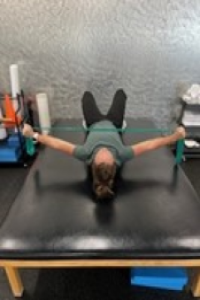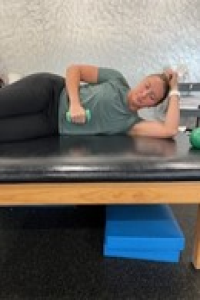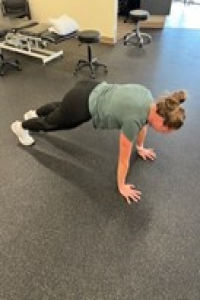Gymnast Wrist
This most often occurs in athletes between 10 and 16 years old, when pain is experienced over the inside of the forearm and wrist when performing an extended movement1.
Grip Lock
Grip lock occurs more often in males than in females. Grips should be fitted every 3-6 months, as “stretched out” grips tend to increase the risk of this injury1.
Osteochondritis Dissecans (OCD)
Athletes between 10-14 years old most often experience OCD pain with elbow extension and weight bearing with an extended elbow. Pain on the back and outer elbow can also occur. This feels like a “catching” or “locking” sensation, causing the elbow to have a limited range of motion1.
Medial Tensile Injuries
This often presents as pain inside the athlete’s elbow followed by numbness or tingling in the pinky and ring fingers1.
Glenohumeral Instability
This injury commonly results in pain in the front of the shoulder followed by a “clicking” or “catching” sensation1.
Strengthening and Stabilization Interventions
Gymnasts need sufficient strength in their rotator cuff and scapular musculature to perform at their best. Let’s examine strengthening and stabilization exercises with different levels of complexity depending on the athlete’s developmental level, as well as stretches for tight muscles. As with any exercise, please talk with your physician prior to engaging in the activities outlined below.
Lower Trapezius Strengthening
Lower Trapezius Wall Lift Off (Easy Complexity)
This exercise aims to drive the bottom tip of your shoulder blade into your back pocket while lifting your hand off the wall.
Middle Trapezius Strengthening
Supine on Foam Roll T (Low Complexity)
This exercise aims to pinch your shoulder blades towards your spine and into the foam roll as you pull the band apart.
Posterior Rotator Cuff Strengthening
External Rotation with Dumbbell or Resistance Band (Low Complexity)
This exercise aims to pinch the shoulder blade towards your spine while keeping the arm at your side and rotating the forearm away from your body.
Serratus Anterior Strengthening
Wall Slides with External Rotation Isometric (Moderate Complexity)
This exercise aims to focus on pushing the shoulder blades out and around your ribcage while keeping the tension at your wrists and elbows under the hands.
Shoulder Stabilization
Downward Dog with Scapula Setting (Moderate Complexity)
This exercise aims to drive your shoulder blades into your back pocket as you lift your hips into the air and pinch your shoulder blades towards your spine as you return into the push-up position.
Shoulder Mobility
Pec Stretch
Lat Stretch
These movements can help gymnasts of all levels improve overall strength, create better stability, and reduce the potential risk of injury so they can continue to compete at peak performance! If you or your athlete experience pain during practice or when performing exercises like the ones above, contact your nearest Athletico location to talk with a licensed physical therapist who can help.
*Per federal guidelines, beneficiaries of plans such as Medicare, Medicaid, Tricare, VHA and other federally funded plans are not eligible for free assessments.
The Athletico blog is an educational resource written by Athletico employees. Athletico bloggers are licensed professionals who abide by the code of ethics outlined by their respective professional associations. The content published in blog posts represents the opinion of the individual author based on their expertise and experience. The content provided in this blog is for informational purposes only, does not constitute medical advice and should not be relied on for making personal health decisions.
References:
1. Hart E, Bauer AS, Bae DS. Common upper extremity gymnastics injuries and gymnastic specific return to play protocols. Journal of the Pediatric Orthopaedic Society of North America. 2024;6:100016-100016. doi: https://doi.org/10.1016/j.jposna.2024.100016

 width="900"
height="356"
>
width="900"
height="356"
>













